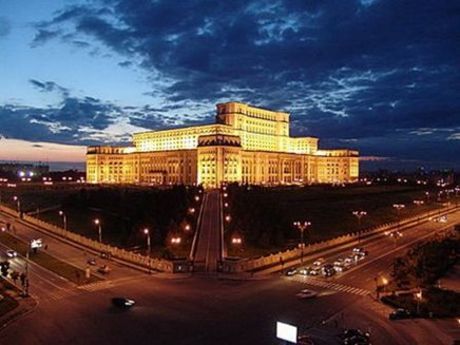Bucharest
Bucharest, located between Transylvania's Carpathian Mountains and the Black Sea, in southeastern Romania, is an often misunderstood city.
Known for its wide, tree-lined boulevards, glorious Belle Époque buildings and a reputation for the high life (which in the 1900s earned its nickname of "Little Paris"), Bucharest, Romania's largest city and capital, is today a bustling metropolis. Romanian legend has it that the city of Bucharest was founded on the banks of the Dambovita River by a shepherd named Bucur, whose name literarily means "joy." His flute playing reportedly dazzled the people and his hearty wine from nearby vineyards endeared him to the local traders, who gave his name to the place.
It’s lovely neoclassical buildings and wide tree-lined boulevards inspired the nickname 'Paris of the Balkans' a century ago, but many gems are obscured by post-Stalinist, North Korean-style grey housing blocks built, intentionally, to hide finer architectural moments.
To spot Byzantine-style chapels and bell-towered mansions visitors have to work a little. Impressions depend on how deep a sightseer goes. On the side streets of the historic centre are bars, eateries (French, Italian, Transylvanian), antique shops, a 15th-century court attributed to Vlad Dracul, and Piata Revolutiei, the heart of the 1989 protests that ended communism here in a sudden, bloody swoop (culminating with the execution of Nicolae Ceausescu and his wife). In the ritzy north lies the sprawling Herastrau Park, with boat rides and an open-air Village Museum displaying traditional homes.
Romania joined the EU in 2007, and the sense of a new dynamism all over town is evident in construction projects. Bucharest enjoys a temperate climate, but mid-summer is not a good time to visit, as temperatures soar, air conditioning is rare and many of the locals leave for the coast. Since the 1990s, brand names and high-end stores have been pushing their way into the Romanian market. From high fashion boutiques to art galleries, shopping in Bucharest can fit any taste or budget. Stroll down Blvd. Magheru from Piata Romana to Piata Universitatii for a shopping extravaganza or hit one of the many shopping malls favored by the local rich & famous. Folk crafts, such as embroidered clothing and linen, painted or beaded eggs, carpets, pottery, woodcarvings and icons, make interesting gifts and souvenirs. Romanian peasants do magnificent embroidery on cotton, wool and leather. Look for blouses, skirts, exotic coats, rugs, tablecloths and lacework. Icons, new and old, painted on glass or wood are outstanding. A good selection can be found at the Romanian Peasant Museum, the Village Museum, most department stores. Visitors interested in Romanian music can find recordings of pop artists and bands, such as Loredana Groza and Morandi, pan flute artist Gheorghe Zamfir and popular folk singers such as Maria Tanase.
Bucharest is safe and hospitable. Violent crime against visitors is almost non-existent. As in any large city visitors are advised to take usual safety precautions. Do not draw unnecessary attention to your person, money or jewelry and be aware of pickpockets and scam artists. Never accept taxi/car rides, tours or guide services from strangers, no matter how presentable or fluent in English, who approach you on the street.
Bucharest has a four-season climate. In the spring, the weather can quickly alternate between rain and sunshine. June, July and August are the hottest months. As the leaves begin to change color, you can still enjoy warm and sunny days while taking a stroll in the city's many parks or down Calea Victoriei. Winters can be quite cold with moderate snowfall.
Airport Bucharest - Baneasa is an airport of moderate size in Romania. The airport is used by passengers traveling to Bucharest, which is 8 km away. The airport is also popular for short trips to the city. You can also find airport Bucharest - Baneasa under the code BBU. There are two terminals at airport Bucharest - Baneasa. Henri Coanda (formerly called Otopeni) is the most important Romanian airport. Traditionally, Baneasa has been perceived as Bucharest’s airport, while Otopeni was seen as Romania’s international gateway airport.
Low cost airlines operate mainly international flights from this airport. The airport is a hub for airlines Blue Air and Wizz Air. Airlines GermanWings also offer flights to BBU. There are scheduled domestic flights from/to Cluj-Napoca (CLJ), Iasi (IAS), Oradea (OMR), Satu Mare (SUJ), Sibiu (SBZ), Suceava (SCV), Timisoara (TSR).
Currently the only taxi company licensed to pick-up passengers from the airport is Fly Taxi (telephone: 9411). Fare to downtown Bucharest is about $25. Fly Taxi's fee per km for trips from the airport is about 3.30 Lei ($1.8/mile). Express Bus 783 offers daily service to the city centre, with stops at Baneasa Airport, Piata Presei Libere, Piata Victoriei, Piata Romana, Piata Universitatii and Piata Unirii. The bus leaves from the international departures terminal every 15 minutes (every 30 minutes after 8:30pm and during weekends), from 5:30am until 11:00pm. The journey to downtown takes approximately 40 minutes. Fare is 7 Lei (about $2.5) for a round-trip ticket. Express Bus 780 offers daily service to the main train station (Gara de Nord) with stops at: Henri Coanda Airport - Baneasa Airport - Piata Presei Libere - Clabucet - Gara de Nord - Str. Fluviului. The bus runs every 30 minutes from 5:15 a.m. to 11:00 p.m. seven days a week. It leaves from the international arrivals terminal; the journey to the train station takes 40 minutes to 60 minutes. A roundtrip ticket costs (about $2.50) per trip.




